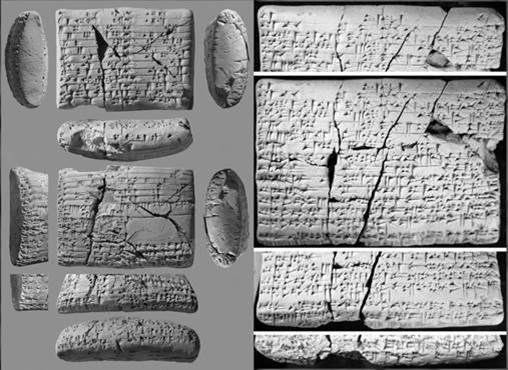In January, the first-ever texts written in the Amorite language were published. This will have far-reaching significance for biblical, historic, and linguistic studies. Prof. Yoram Cohen of the Tel Aviv University Archaeology Department said the publication was “amazing” and of “very fundamental significance”1. Prior to this, our only knowledge of the language was a handful of nouns that appeared as loan words in Akkadian documents. Some scholars even doubted that a written Amorite language existed. The rarity of Amorite texts can be explained by the fact that the dominant language in the second millennium BC was Akkadian. Even as the Amorites increased in power, the language of learning and administration remained Akkadian and Sumerian. The article, “Two Remarkable Vocabularies: Amorite-Akkadian Bilinguals!” by Andrew George and Manfred Krebernik, appeared in Revue ďAssyriologie et ďArchéologie Orientale 116 (2022): 113–66. Andrew George is emeritus professor of Babylonian literature at the University of London’s School of Oriental and African Studies, while Manfred Krebernik is professor and chair of ancient Near Eastern studies at the University of Jena in Germany. The scholars spent six years studying the two cuneiform clay tablets.
The texts were acquired in Iraq some 40 years ago, possibly during the Iran-Iraq War, from 1980 to 1988, but details as to their origin have not been released. Both tablets are similar in nature, with the left column written in Amorite and the right column a translation into Akkadian. Similar bilingual texts have been found before, but this is the first to have translations of Amorite words and phrases into Akkadian. Tablet 1 begins with a list of deities, then constellations, foodstuffs, and types of clothing, all translated into Akkadian in the right column. These items are followed by a section only written in Amorite, of longer phrases and a few literary verses.
 Tablet 1, from the Jonathan and Jeanette Rosen Cuneiform Collection, New York (Rudolph Mayr/Courtesy Rosen Collection). Right, Tablet 2, private collection, London (Courtesy David I. Owen).
Tablet 1, from the Jonathan and Jeanette Rosen Cuneiform Collection, New York (Rudolph Mayr/Courtesy Rosen Collection). Right, Tablet 2, private collection, London (Courtesy David I. Owen).
Tablet 2 consists of bilingual phases in Amorite and Akkadian, which seem to be phrases used in common social interactions. The vocabulary and syntax of the tablets indicate they most likely were written in southern Mesopotamia, the region known as Babylonia. Moreover, the language and handwriting of the two texts are so similar that they may have been written in the same scribal school, possibly by the same scribe. Based on the linguistic features of the cuneiform text, the tablets can be dated to the Old Babylonian period, ca. 1894–1595 BC, the time of the Egyptian Sojourn.
Amorites are often mentioned in the Bible. They originated in southern Mesopotamia in the late third millennium and gradually extended their power westward. By ca. 1800 BC they controlled most of the urban centers in the Levant. When Israel entered the promised land at the end of the 15th century BC, Amorites were listed, along with other indigenous groups, as enemies to be conquered. The Israelites went on to defeat the ruling Amorite kings in both Transjordan and Cisjordan.
The amazing thing about the underlying Amorite language in the tablets is that it is a North-West Semitic language nearly identical to biblical Hebrew. Prof. Cohen stated, “In this text, which is very, very ancient, words appear that anyone who knows Hebrew will immediately recognize. You don’t have to be a linguist to understand the connection to Hebrew.” He went on to say that the texts prove, “…beyond a shadow of a doubt” that already in the second millennium BC there was a spoken language that was very close to Hebrew2. This is not surprising, since, according to the biblical record, the Israelites originally came from the region of Haran in upper Mesopotamian, where North-West Semitic was the common language. The Amorites developed a written form of their language using the cuneiform logo-syllabic script, whereas the Israelites developed a written form of their language using an alphabetic script based on Egyptian hieroglyphs, as described by ABR Research Associate Douglas Petrovich in his book, The World’s Oldest Alphabet (2016).
The Amorite tablets are of special interest to ABR, not only because they link the Israelites to their original ancestral homeland, but also because they relate to our Khirbet el-Maqatir dig in Israel. We uncovered the remains of a Bronze Age fortress dating to ca. 1650–1406 BC, possibly during, or, more likely, just after, the time of the tablets. It guarded the northern border of the territory of Jerusalem, which was ruled by an Amorite king. Regarding the founding of Jerusalem, Ezekiel said, “…your father was an Amorite and your mother a Hethite (Ez 16:3). Thus, it was Amorites who built and manned the Khirbet el-Maqatir fortress. They were known for their monumental constructions, which we can attest to at Khirbet el-Maqatir! According to Amos, they were tall and strong: “I destroyed the Amorite before them [Israel], though he was tall as the cedars and strong as the oak…” (Am 2:9).
Footnotes:
1. Ofer Aderet, "Two 3800-year-old cuneiform tablets found in Iraq give first glimpse of Hebrew precursor," Haaretz, June 20,2023, https://www.haaretz.com/archaeology/2023-01-20/ty-article/two-3-800-year-old-cuneiform-tablets-found-in-iraq-give-first-glimpse-of-hebrew-precursor/00000185-ca23-d3a8-a3cf-cf3326430000
2. Aderet, "Two 3800-year-old cuneiform tablets found in Iraq give first glimpse of Hebrew precursor." https://www.haaretz.com/archaeology/2023-01-20/ty-article/two-3-800-year-old-cuneiform-tablets-found-in-iraq-give-first-glimpse-of-hebrew-precursor/00000185-ca23-d3a8-a3cf-cf3326430000











